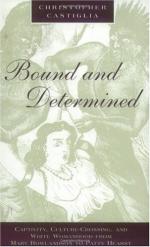|
This section contains 6,947 words (approx. 24 pages at 300 words per page) |

|
SOURCE: “The Journey Between: Liminality and Dialogism in Mary White Rowlandson's Captivity Narrative,” in Early American Literature, Vol. 28, No. 1, 1993, pp. 60-75.
In the essay that follows, Burnham examines the significance of Rowlandson's two narrative voices, the “colloquial” and the “biblical,” arguing that this dialogism arises from her Puritan, European culture coming into contact with the Native American culture of her captors.
In the introductory segment of her captivity narrative, before the story becomes structured into a series of “removes,” Mary Rowlandson succinctly states her purpose: “that I may the better declare what happened to me during that grievous Captivity” (121). Throughout the succeeding twenty removes, this middle-aged Puritan woman—the wife of a minister and the daughter of the wealthiest original landowner in Lancaster, Massachusetts—records her experience during the eleven weeks and five days she spent as a captive among the New England Indians. Her narrative begins with...
|
This section contains 6,947 words (approx. 24 pages at 300 words per page) |

|


